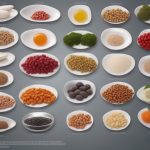Urological conditions can significantly impact daily life, often causing discomfort and disruption after meals. Many individuals experience increased pressure or urgency in the bladder region following food intake, leading to anxiety around eating and potential lifestyle limitations. This isn’t always indicative of a worsening condition; it’s frequently related to how specific foods interact with the urinary system and overall digestive process. Understanding this connection is crucial for managing symptoms and improving quality of life. A thoughtfully planned diet can play a pivotal role in alleviating pressure, reducing irritation, and promoting optimal urological health, working alongside any medical treatments prescribed by a healthcare professional.
The relationship between diet and urological health isn’t always straightforward. It’s not simply about avoiding certain foods; it’s about creating a balanced dietary approach that minimizes triggers and supports the body’s natural regulatory mechanisms. Factors like hydration levels, fiber intake, and even meal timing can all play a part. While individual sensitivities vary considerably, there are common dietary patterns and food groups that often exacerbate urological symptoms or contribute to bladder irritation. This article will explore strategies for implementing a diet designed to ease pressure after meals, focusing on practical advice and evidence-based information. It’s important to remember that this is general guidance and consulting with a registered dietitian or your healthcare provider is vital to tailor a plan specific to your needs and condition.
Dietary Principles for Urological Comfort
The cornerstone of a urology-focused diet lies in minimizing bladder irritants and optimizing hydration. Many common foods and beverages possess properties that can directly stimulate the bladder, leading to increased urgency, frequency, or discomfort. These aren’t necessarily “bad” foods – many people tolerate them perfectly well – but for individuals experiencing post-meal pressure, identifying and reducing intake is a key step towards relief. This often involves a period of elimination diet where suspected triggers are removed temporarily and then reintroduced slowly to assess tolerance.
Hydration, conversely, is paramount, yet it’s a nuanced aspect. While adequate fluid intake is essential for overall health and helps dilute urine, reducing bladder irritation, drinking excessive amounts at once can overwhelm the bladder. Spreading fluid consumption throughout the day, rather than large gulps, is generally recommended. Water should be the primary beverage of choice, with herbal teas (caffeine-free) also offering a good option. Conversely, beverages like coffee, alcohol, and carbonated drinks are known to irritate the bladder in many individuals and may need to be limited or avoided. Prioritizing consistent hydration, rather than sporadic large intakes, is essential. For those looking for ways to improve their overall dietary habits alongside urological health, exploring a smart approach to sugar management can be particularly helpful.
Finally, fiber plays a surprisingly important role. Constipation can put extra pressure on the bladder and pelvic floor muscles, exacerbating symptoms. A diet rich in fiber – from sources like fruits, vegetables, and whole grains – promotes regular bowel movements and reduces this strain. However, it’s also crucial to increase water intake alongside increased fiber consumption to prevent constipation from worsening. The goal is a balanced approach that supports both digestive and urological health.
Foods to Consider & Limit
Identifying specific foods that trigger symptoms is highly individualistic. However, certain categories are frequently associated with bladder irritation. Citrus fruits (oranges, grapefruit, lemons) contain high levels of citric acid, which can be irritating for some. Similarly, tomatoes and tomato-based products (sauces, juices) can also contribute to discomfort. Spicy foods, due to capsaicin, often increase urgency and burning sensations. Artificial sweeteners are another common culprit – many individuals report increased symptoms after consuming products containing aspartame or saccharin.
On the other hand, incorporating bladder-soothing foods can be beneficial. Foods with anti-inflammatory properties, such as blueberries, pears, and cucumbers, may help reduce overall irritation. Complex carbohydrates like sweet potatoes and oatmeal are generally well-tolerated and provide sustained energy without significant bladder impact. Lean proteins are preferred over fatty meats, which can contribute to digestive discomfort and indirectly affect the bladder. Focusing on a diet based around whole, unprocessed foods is always a good starting point. A thoughtful dietary approach can also complement other lifestyle adjustments; consider incorporating daily lower back care to further support overall urological health.
Managing Meal Timing & Portion Sizes
The timing of your meals relative to bedtime and fluid intake can significantly influence urological symptoms. Eating large meals close to bedtime can put pressure on the bladder overnight, leading to increased frequency and urgency. Aim to finish eating at least 2-3 hours before going to bed. Similarly, avoid consuming large amounts of fluids right before leaving the house or engaging in activities where access to a restroom is limited.
Portion control plays a crucial role too. Overeating can stretch the stomach and put pressure on surrounding organs, including the bladder. Smaller, more frequent meals throughout the day may be easier for your system to handle than large, infrequent ones. This also aids digestion, reducing the likelihood of constipation and its associated bladder issues. Consider adopting the principles of mindful eating – paying attention to hunger cues and savoring each bite – to prevent overeating.
The Role of Caffeine & Alcohol
Caffeine is a well-known bladder irritant. It acts as a diuretic, increasing urine production, and can also directly stimulate the bladder muscles. Reducing or eliminating caffeine intake – from coffee, tea, soda, and even chocolate – often leads to significant improvement in urological symptoms. If complete elimination feels daunting, try gradually reducing your consumption.
Alcohol, similarly, has diuretic properties and can irritate the bladder lining. It’s best to limit alcohol intake or avoid it altogether if you are experiencing post-meal pressure. When consuming alcohol, be sure to hydrate adequately with water to counteract its dehydrating effects. Understanding that these substances directly impact bladder function is key to making informed choices. To further support your dietary efforts, learning about essential pantry staples can simplify meal preparation and ensure you always have urology-friendly options on hand.
Keeping a Food & Symptom Diary
One of the most effective ways to identify your personal triggers is by keeping a detailed food and symptom diary. This involves recording everything you eat and drink, as well as any urological symptoms you experience – including frequency, urgency, pain levels, and timing. After several weeks, you can analyze the diary to pinpoint potential connections between specific foods and your symptoms.
- Record all food and beverage consumption, including portion sizes.
- Note the time of day when symptoms occur.
- Describe the nature and severity of your symptoms (e.g., mild urgency, moderate pain).
- Look for patterns and correlations between diet and symptom fluctuations.
- Share this diary with your healthcare provider or a registered dietitian to develop a personalized dietary plan.
This proactive approach empowers you to take control of your health and identify the specific dietary modifications that will provide the most relief. Remember, consistency is key – maintaining a healthy diet and hydration habits over the long term is crucial for managing urological symptoms and improving overall well-being. Integrating a structured 3-meal plan can help establish these habits more effectively.
Furthermore, recognizing the connection between diet and overall wellbeing extends beyond just urological health. Exploring key nutrients for tissue recovery can enhance your body’s natural healing processes.
Finally, remember that even small adjustments to your daily routine can make a big difference. Consider incorporating strategic meal spacing throughout the day to minimize pressure and discomfort.





















